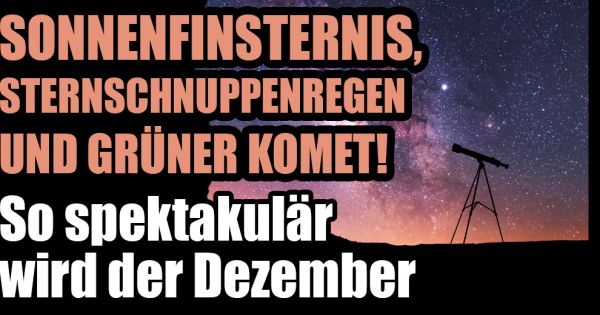Concerned astronomers get their money’s worth in December 2021: In addition to the full moon, they can look forward to the falling stars of Gemini, the total solar eclipse and the green comet. You can find all the information about the observation times here.
December has some highlights in store for amateur astronomers.
Photo: AdobeStock / None Av
Interested astronomers can look forward to the many highlights of the starry sky in December. In addition to the towering stars of the Geminids and full moon Bright awaits comet as well as solar eclipse employment.
The total solar eclipse on December 4, 2021 cannot be observed from Germany
On December 4, 2021, the moon not only reaches the new moon phase, but also pushes itself in front of and eclipses the sun. Unfortunately, the total solar eclipse cannot be observed from Germany. It can be seen only in the southernmost regions of the world.
Geminids in December 2021: Up to 150 falling stars visible per hour
Between December 6-16, 2021, the falling stars of Geminids will blaze in the sky. Meteor showers reach their peak on the night of December 13 to 14. Then up to 150 meteors should appear per hour. The best time to observe should be between 9 pm and 6 am. However, Geminids aren’t the only stream of shooting stars in December: Ursids (December 15-24, 2021) can also be seen shortly before Christmas.
Comet Leonard in December 2021: Poinsettia shines in the sky
However, falling stars are not the only flares that can be seen in the sky. Comet Leonard (C/2021 A1) can also be seen through mid-December.In the Northern Hemisphere, C/2021 A1 can be seen in the early morning hours just before sunrise in the southeast sky in the constellation Bootes (Bear Guardian) until December 12.
December 19, 2021 full moon: What does a frozen snow moon predict?
At exactly 5.35 am, the moon will reach its full moon on December 19, 2021. The day before, the moon was 406,320 kilometers from Earth. By the way, the December full moon has some special nicknames – such as the July moon, the cold moon, and the long night moon. The names came from the observation of natural phenomena. The longest full moon night of the year is in December.
The winter solstice on December 21, 2021 marks the astronomical start of winter
The winter solstice will occur on December 21, 2021. The sun passes at the lowest point in its annual orbit at 4:59 pm. On this day we witness not only the shortest day but also the longest night of the year.
Asteroids XXL in December – an overview of all the rocks near Earth
Giant boulders get close to Earth almost every day – this was also the case in December 2021. Fortunately, most of them are at a safe distance. NASA is still monitoring some of them. Better safe than sorry. After all, a person can leave his or her path and hit the ground. The largest asteroids near Earth in December can be found here:
| Noun | date | distance to earth | Diameter |
| asteroid 4660 Nereus (1982 dB) | December 11, 2021 at 3:51 p.m. | 3.9 million km | 330 meters |
| Asteroid 163899 (2003 SD220) | 11/17/2021, 7:26 PM | 5.4 million km | 791 m |
| Asteroid 2016 TR54 | December 24, 2021 at 8.30 am | 6,5 kilometers | 100 – 230 meters |
| asteroid 2018 e | December 27, 2021, 6:27 pm | 4.5 million km | 84 – 190 meters |
| Asteroid 2017 AE3 | December 29, 2021, 3:54 am | 3.5 million km | 120 – 260 meters |
All data without warranty!
follow on News.de already in Facebook social networking site And Youtube? Here you will find the latest news, the latest videos, great contests and a direct line for editors.
bua / fka / news.de / dpa





More Stories
Nvidia GeForce RTX 4090: AIDA64 gets Ada spearhead support
Rogue Trader – Details about the first cRPG in the series – CD-Action
t3n – Digital Pioneers | digital business magazine